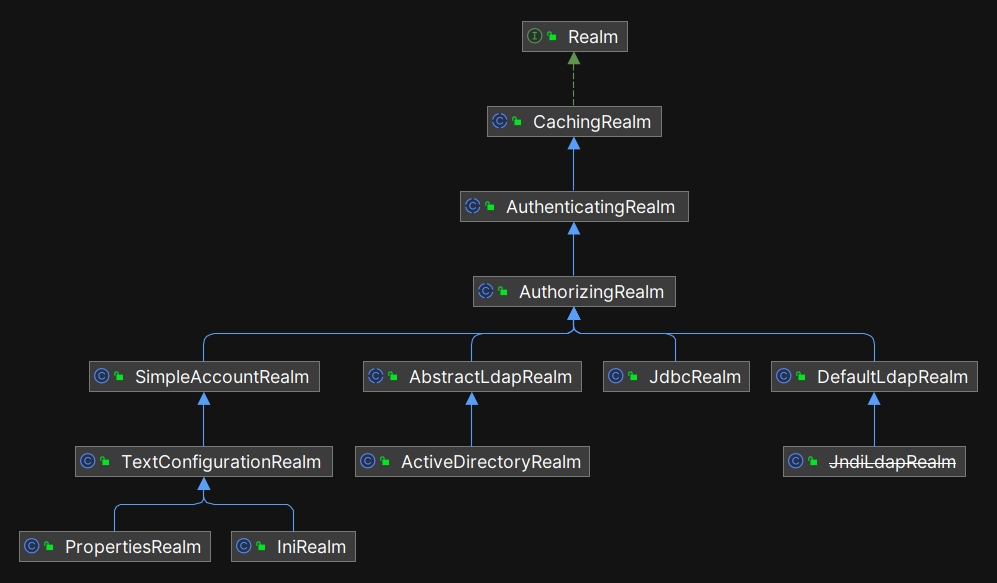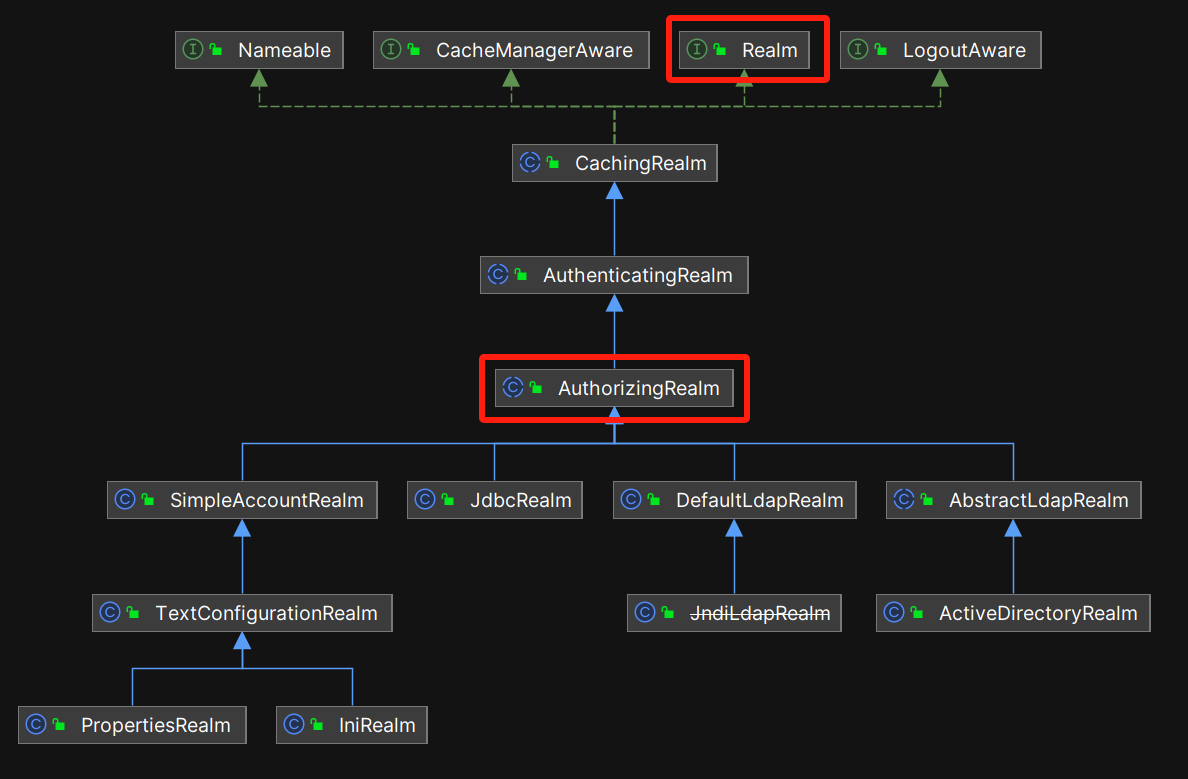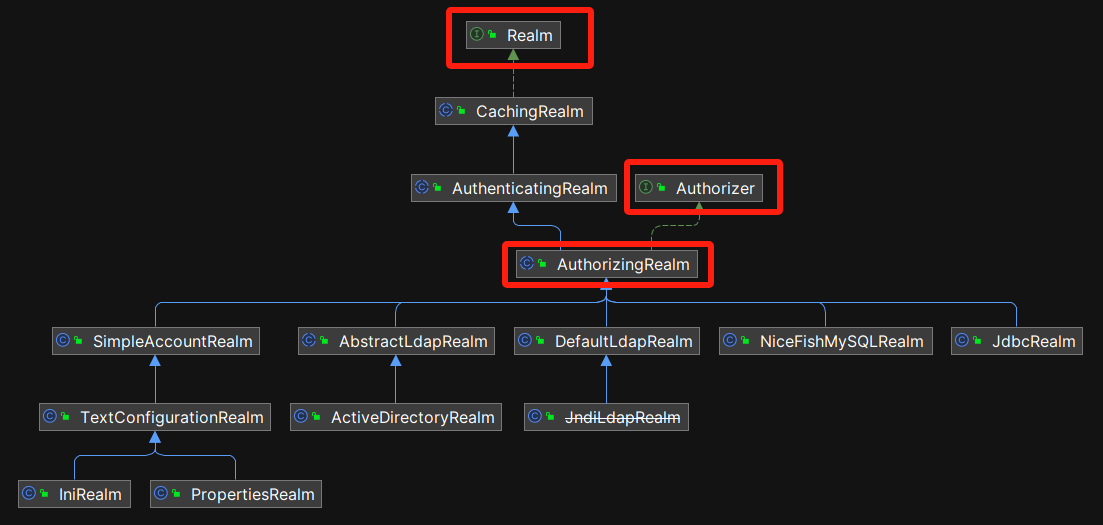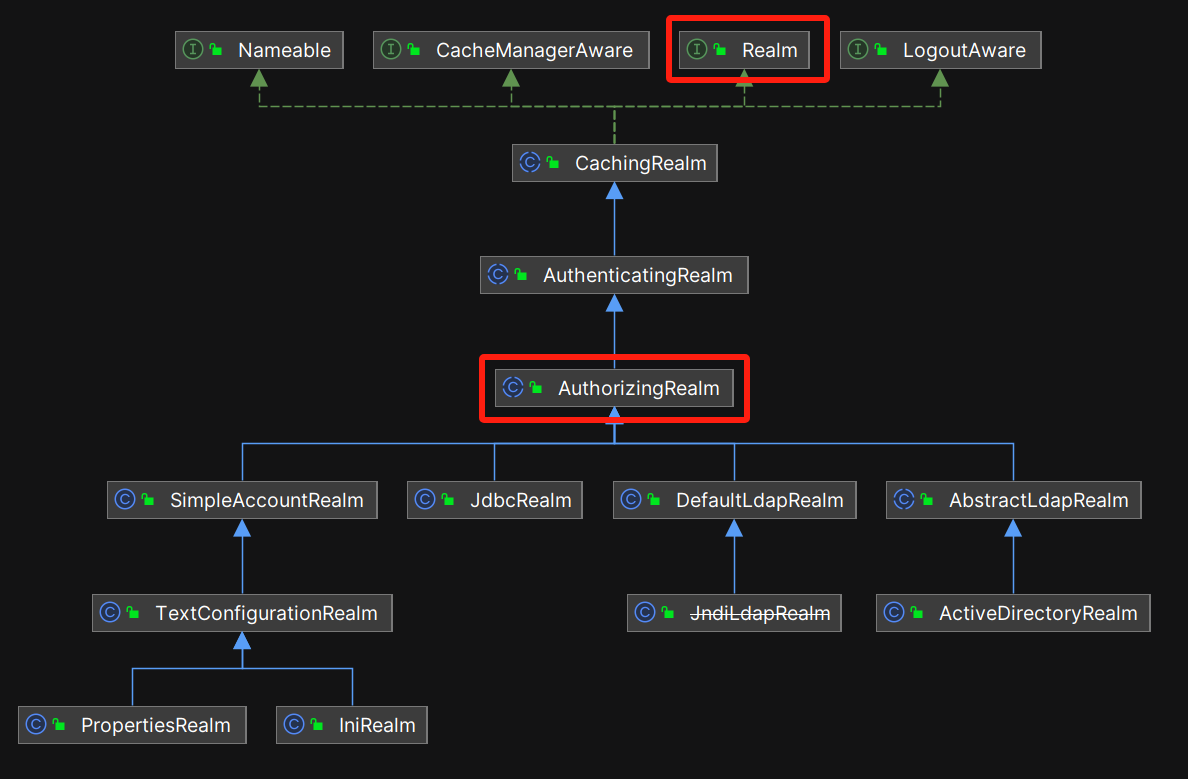《Apache Shiro 源码解析》- 4.领域
原创《Apache Shiro 源码解析》- 4.领域
原创

4.领域
4.1 什么是领域-Realm
在实际的业务系统中,通常存在一些需要被保护的数据源,例如:
- 关系型数据库(最常见)
- LDAP 目录
- 某些 API 服务的路径,如
/user/photos/?
显然,我们需要一个术语来准确描述这些数据源。在 Shiro 中,使用了 Realm 这一术语。Realm 的音标为 /rɛlm/,字面意思是“领地”、“领域”。在本书中,我们将其翻译为“领域”。这一词语不仅寓意深刻,而且避免了与任何现有类名的冲突。
当某个数据源需要被保护时,可以将其定义为一个 Realm(领域)。任何试图访问该“领域”的主体,都必须通过身份验证并获得授权。Realm 充当了数据源与安全控制逻辑之间的桥梁,它的本质是一个 DAO(数据访问对象)。
4.2 Realm 接口源代码解析
4.2.1 Realm 相关的继承结构
Shiro 中 Realm 相关的类继承结构如下图所示:

以下是各个类(接口)的功能(读者浏览即可,不需要记忆):
类(接口)名 | 功能描述 |
|---|---|
Realm | Shiro 的核心接口,定义从数据源获取身份验证和授权信息的基本操作。 |
CachingRealm | 带有缓存支持的 |
AuthenticatingRealm | 提供身份验证功能的 |
AuthorizingRealm | 在身份验证的基础上增加授权功能,通过 |
SimpleAccountRealm | 简单的 |
TextConfigurationRealm | 继承自 |
PropertiesRealm |
|
IniRealm | 从 |
AbstractLdapRealm | 基于 LDAP 的 |
ActiveDirectoryRealm | 继承自 |
JdbcRealm | 基于 JDBC 的 |
DefaultLdapRealm | 继承自 |
JndiLdapRealm (已过期) | 继承自 |
在上述类(接口)的继承结构中,大多数代码都相对简单。我们只需重点分析 Realm 和 AuthorizingRealm 这两个核心类型,即可完整理解该设计和实现的整体逻辑。
4.2.2 Realm 接口
Realm 是顶级接口,它的源代码非常简单,只规定了 3 个方法。
package org.apache.shiro.realm;
import org.apache.shiro.authc.AuthenticationException;
import org.apache.shiro.authc.AuthenticationInfo;
import org.apache.shiro.authc.AuthenticationToken;
public interface Realm {
String getName(); //很明显,Realm 的名字应该是全局唯一的,不可以重复。
boolean supports(AuthenticationToken token);
AuthenticationInfo getAuthenticationInfo(AuthenticationToken token) throws AuthenticationException;
}String getName():该方法返回Realm的名字。Realm的名字在全局范围内应该是唯一的,不能重复。它用于标识和区分不同的Realm实现。boolean supports(AuthenticationToken token):该方法用于判断当前Realm是否支持处理传入的AuthenticationToken。不同的Realm可能支持不同类型的令牌,这个方法根据令牌类型做出判断,返回true或false。AuthenticationInfo getAuthenticationInfo(AuthenticationToken token) throws AuthenticationException:该方法根据传入的AuthenticationToken提供相应的AuthenticationInfo,用于进行身份验证。如果认证失败,则抛出AuthenticationException异常。
这三个方法定义了 Realm 的基本功能,分别负责标识、支持性检查和获取验证信息。
4.2.3 AuthorizingRealm 源码解析
与验证和授权相关的两个子接口是: AuthenticatingRealm 和 AuthorizingRealm ,如下图所示:

其中 AuthorizingRealm 是 AuthenticatingRealm 的子接口,采用这种继承结构的意图很好理解:既然要进行授权,那必然先要进行身份验证。如果连身份验证都不需要,当然不需要进行授权管理,所以授权接口设计成验证接口的子类在逻辑上是一致的。
在日常开发中,业务代码都应该是 AuthorizingRealm 的子类型,开发者可以直接选用 Shiro 内置的实现类,也可以自己实现 AuthorizingRealm 接口。例如,在本书最后一章的例子中, NiceFish 项目自己定义了一个 NiceFishMySQLRealm ,代码如下:
public class NiceFishMySQLRealm extends AuthorizingRealm我们来看 AuthorizingRealm 的实现。

从继承结构图可以看出,AuthorizingRealm 同时实现了 Realm 和 Authorizer 接口,这一点也在它的类名中得到了体现。在 AuthorizingRealm 这一层级,主要关注的是授权功能的实现。该类重载了大量 isPermitted 方法,并提供了一系列用于角色和权限检测的功能方法。由于 AuthorizingRealm 的实现代码相对简单,这里不详细列举源码。
4.3 同时使用多个 Realm
对于大型的业务系统来说,可以同时定义多个 Realm ,用来保护不同的数据源。例如,除了 MySQL 数据库之外,客户还要求 NiceFish 支持 Oracle 数据库,那么我们可以编写一个新的 Realm ,叫做 NiceFishOracleRealm ,伪代码如下:
public class NiceFishOracleRealm extends AuthorizingRealm在实际业务中,通常需要处理多个认证源,最常见的业务场景是:主体可以通过当前系统的登录接口进行验证,也可以通过第三方认证(例如微信、QQ)登录系统。
如果开发者自己逐个编写代码尝试登录,那么业务代码会变得非常冗长, Shiro 在框架层面提供了多 Realm 支持,只要我们把所有需要“尝试登录”的 Realm 都配置给它, Shiro 就会按照指定的策略逐个进行尝试,这样就可大幅度简化上层业务代码。
4.3.1 多 Realm 用法示例
DatabaseRealm - 负责从本地数据库中认证主体。
import org.apache.shiro.authc.AuthenticationException;
import org.apache.shiro.authc.AuthenticationInfo;
import org.apache.shiro.authc.AuthenticationToken;
import org.apache.shiro.authc.UsernamePasswordToken;
import org.apache.shiro.authc.SimpleAuthenticationInfo;
import org.apache.shiro.realm.Realm;
public class DatabaseRealm implements Realm {
@Override
public String getName() {
return "DatabaseRealm";
}
@Override
public boolean supports(AuthenticationToken token) {
return token instanceof UsernamePasswordToken;
}
@Override
public AuthenticationInfo getAuthenticationInfo(AuthenticationToken token) throws AuthenticationException {
UsernamePasswordToken upToken = (UsernamePasswordToken) token;
String username = upToken.getUsername();
String password = new String(upToken.getPassword());
// 假设 "user1" 的密码是 "password1"
if ("user1".equals(username) && "password1".equals(password)) {
return new SimpleAuthenticationInfo(username, password, getName());
}
throw new AuthenticationException("Invalid username or password.");
}
}OAuthRealm - 负责从第三方接口(如阿里云)进行 OAuth 认证。
import org.apache.shiro.authc.AuthenticationException;
import org.apache.shiro.authc.AuthenticationInfo;
import org.apache.shiro.authc.AuthenticationToken;
import org.apache.shiro.authc.UsernamePasswordToken;
import org.apache.shiro.authc.SimpleAuthenticationInfo;
import org.apache.shiro.realm.Realm;
public class OAuthRealm implements Realm {
@Override
public String getName() {
return "OAuthRealm";
}
@Override
public boolean supports(AuthenticationToken token) {
return token instanceof UsernamePasswordToken;
}
@Override
public AuthenticationInfo getAuthenticationInfo(AuthenticationToken token) throws AuthenticationException {
UsernamePasswordToken upToken = (UsernamePasswordToken) token;
String username = upToken.getUsername();
String password = new String(upToken.getPassword());
// 假设 "user2" 的密码是 "password2"
if ("user2".equals(username) && "password2".equals(password)) {
return new SimpleAuthenticationInfo(username, password, getName());
}
throw new AuthenticationException("Invalid username or password.");
}
}MultiRealmExample - 入口代码。
import org.apache.shiro.mgt.DefaultSecurityManager;
import org.apache.shiro.SecurityUtils;
import org.apache.shiro.subject.Subject;
import org.apache.shiro.authc.UsernamePasswordToken;
import org.apache.shiro.authc.AuthenticationException;
import java.util.Arrays;
public class MultiRealmExample {
public static void main(String[] args) {
// 创建两个 Realm
DatabaseRealm databaseRealm = new DatabaseRealm();
OAuthRealm oauthRealm = new OAuthRealm();
// 配置 SecurityManager,设置多个 Realm
DefaultSecurityManager securityManager = new DefaultSecurityManager();
securityManager.setRealms(Arrays.asList(databaseRealm, oauthRealm));
// 将 SecurityManager 设置到当前环境
SecurityUtils.setSecurityManager(securityManager);
// 获取当前主体
Subject currentUser = SecurityUtils.getSubject();
// 创建一个 Token 实例
UsernamePasswordToken token = new UsernamePasswordToken("user1", "password1");
try {
// Shiro 会根据配置的 Realm 顺序进行认证
currentUser.login(token);
System.out.println("User authenticated successfully.");
} catch (AuthenticationException e) {
System.out.println("Authentication failed: " + e.getMessage());
}
}
}在上述示例中,我们配置了两个 Realm:DatabaseRealm 和 OAuthRealm。Shiro 默认的认证策略是第一个成功策略(First Successful Strategy),即依次尝试每个 Realm,只要有一个 Realm 成功认证,整个认证过程就算成功。
那么,如果我们希望“所有 Realm 都认证成功才能算整体认证成功”应该怎么办呢?我们可以让 Shiro 使用 AllSuccessfulStrategy 策略,修改代码如下:
// 创建两个 Realm
DatabaseRealm databaseRealm = new DatabaseRealm();
OAuthRealm oauthRealm = new OAuthRealm();
// 创建 ModularRealmAuthenticator 验证器并设置认证策略
ModularRealmAuthenticator authenticator = new ModularRealmAuthenticator();
**authenticator.setAuthenticationStrategy(new AllSuccessfulStrategy());**
// 配置 SecurityManager,设置自定义的 Authenticator 和多个 Realm
DefaultSecurityManager securityManager = new DefaultSecurityManager();
securityManager.setAuthenticator(authenticator);
securityManager.setRealms(Arrays.asList(databaseRealm, oauthRealm));
// 将 SecurityManager 设置到当前环境
SecurityUtils.setSecurityManager(securityManager);修改之后, Shiro 将会依次调用 databaseRealm 和 oauthRealm 进行验证,只有两次全部验证成功,才算最终验证成功。
从以上实例可以看到, Shiro 这种整合多个 Realm 的封装非常强大,而且可以大幅度简化上层的业务代码。
4.3.2 多 Realm 的身份验证策略
Shiro 封装了同时处理多个 Realm 的策略:

- First Successful Strategy(第一个成功策略): 这是默认的策略,尝试第一个
Realm成功后,认证过程即算成功。 - All Successful Strategy(全部成功策略):所有
Realm必须成功认证才能通过认证。 - At Least One Successful Strategy(至少一个成功策略):只要有一个
Realm成功认证,认证就算成功,但它允许多个Realm认证成功。 - Custom Strategy(自定义策略):Shiro 允许开发者实现自定义的认证策略,可以继承
AuthenticatingRealm并实现Authenticator接口,以创建适合特定应用场景的认证策略。这种策略非常灵活,可以根据业务需求进行定制。
Shiro 内置的认证策略能够覆盖大多数业务场景,自定义策略则适用于更复杂或特殊的需求。
4.3.3 多 Realm 机制源码解析
那么, Shiro 是如何实现多 Realm 机制的呢?

在 ModularRealmAuthenticator 中 doAuthenticate 方法会判断当前主体关联了多少个 Realm ,如果只关联了一个 Realm ,则调用 doSingleRealmAuthentication 完成验证;如果关联了多个 Realm ,则调用 doMultiRealmAuthentication 进行多 Realm 验证,关键代码如下(已省略无关代码):
protected AuthenticationInfo doAuthenticate(AuthenticationToken authenticationToken) throws AuthenticationException {
assertRealmsConfigured();
Collection<Realm> realms = getRealms();
if (realms.size() == 1) {
return doSingleRealmAuthentication(realms.iterator().next(), authenticationToken);
} else {
return doMultiRealmAuthentication(realms, authenticationToken);
}
}在 doMultiRealmAuthentication 方法中, Shiro 会遍历所有 Realm ,按照指定的策略逐个尝试验证,并且把最终结果整合起来返回:
protected AuthenticationInfo doMultiRealmAuthentication(Collection<Realm> realms, AuthenticationToken token) {
AuthenticationStrategy strategy = getAuthenticationStrategy();
AuthenticationInfo aggregate = strategy.beforeAllAttempts(realms, token);
if (log.isTraceEnabled()) {
log.trace("Iterating through {} realms for PAM authentication", realms.size());
}
//注意这里, Shiro 会遍历开发者配置的所有 Realm ,逐个尝试验证。
for (Realm realm : realms) {
try {
aggregate = strategy.beforeAttempt(realm, token, aggregate);
} catch (ShortCircuitIterationException shortCircuitSignal) {
// Break from continuing with subsequnet realms on receiving
// short circuit signal from strategy
break;
}
if (realm.supports(token)) {
log.trace("Attempting to authenticate token [{}] using realm [{}]", token, realm);
AuthenticationInfo info = null;
Throwable t = null;
try {
info = realm.getAuthenticationInfo(token);
} catch (Throwable throwable) {
t = throwable;
if (log.isDebugEnabled()) {
String msg = "Realm [" + realm + "] threw an exception during a multi-realm authentication attempt:";
log.debug(msg, t);
}
}
aggregate = strategy.afterAttempt(realm, token, info, aggregate, t);
} else {
log.debug("Realm [{}] does not support token {}. Skipping realm.", realm, token);
}
}
//注意这里,整合所有 Realm 的验证结果
aggregate = strategy.afterAllAttempts(token, aggregate);
return aggregate;
}4.4 本章小结
在这一章中,我们详细分析了 Realm(领域)的架构与实现,包括同时支持多个 Realm 进行认证和授权的实现方式。
资源链接
- Apache Shiro 在 github 上的官方仓库: https://github.com/apache/shiro
- Apache Shiro 官方网站:https://shiro.apache.org/
- 本书实例项目:https://gitee.com/mumu-osc/nicefish-spring-boot
- 本书文字稿:https://gitee.com/mumu-osc/apache-shiro-source-code-explaination
版权声明
本书基于 CC BY-NC-ND 4.0 许可协议发布,自由转载-非商用-非衍生-保持署名。
版权归大漠穷秋所有 © 2024 ,侵权必究。
原创声明:本文系作者授权腾讯云开发者社区发表,未经许可,不得转载。
如有侵权,请联系 cloudcommunity@tencent.com 删除。
原创声明:本文系作者授权腾讯云开发者社区发表,未经许可,不得转载。
如有侵权,请联系 cloudcommunity@tencent.com 删除。
